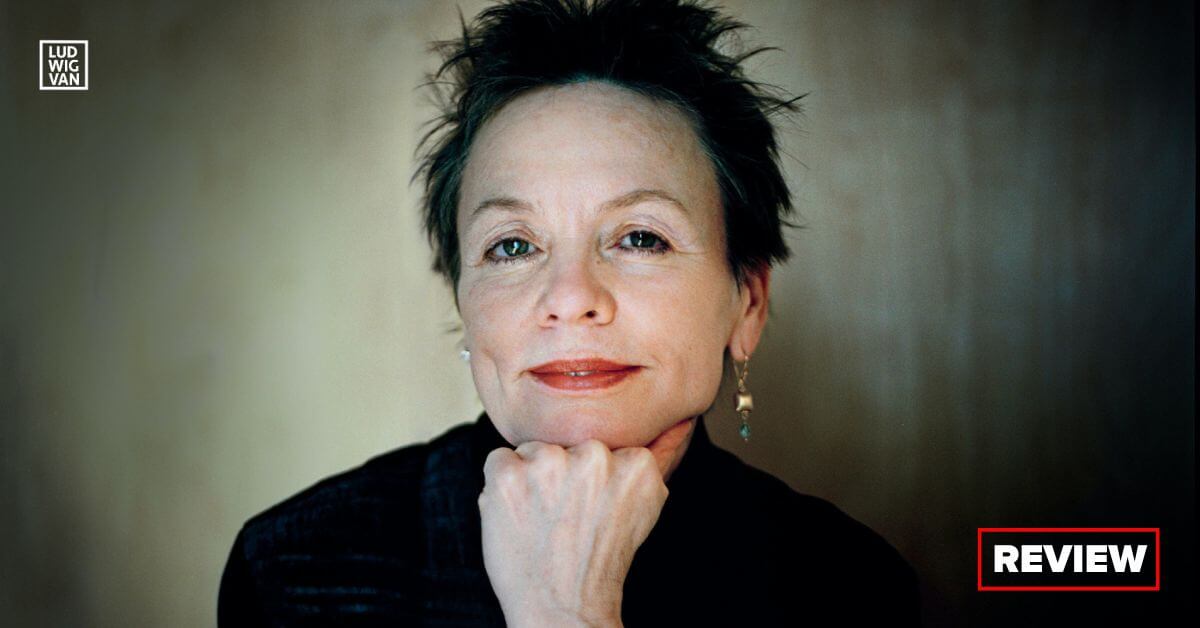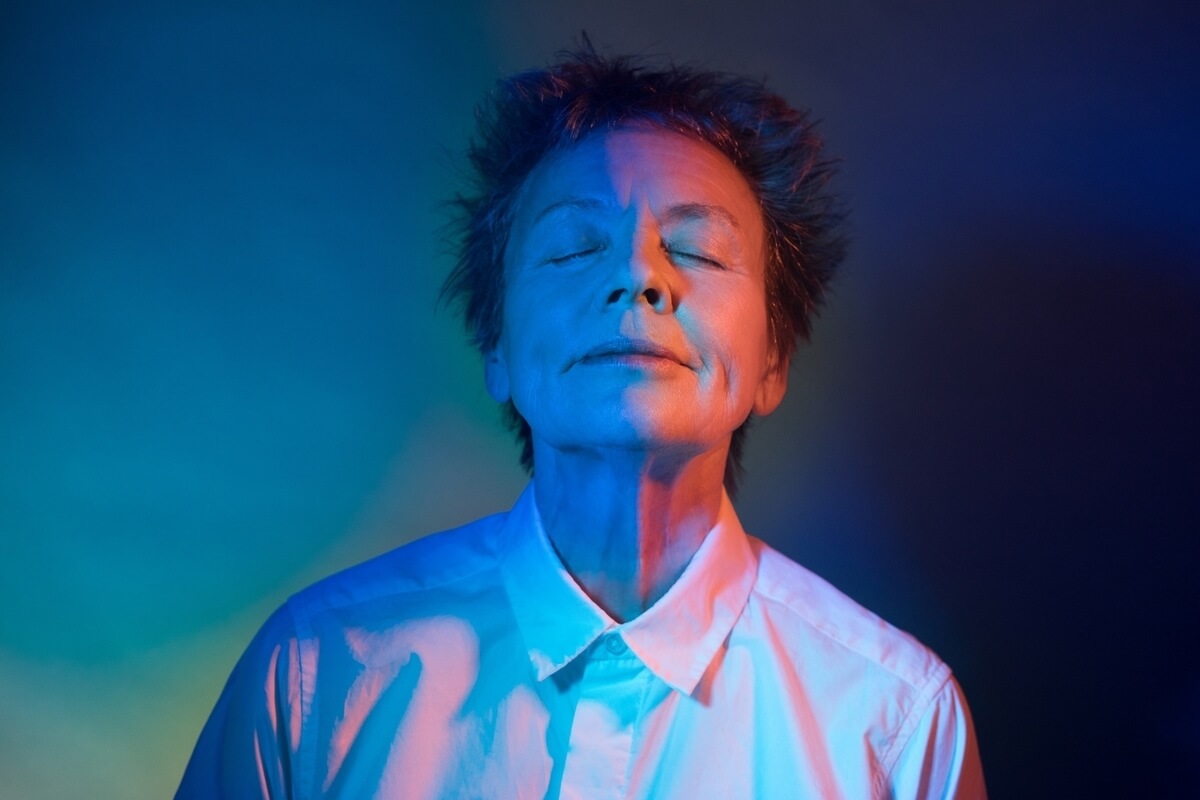
Laurie Anderson: let x=x. April 5, 2024; Koerner Hall.
Laurie Anderson took the full-capacity Koerner Hall audience for a trip through the rabbit hole in her solo show: let x=x, on Friday evening.
Anderson has been rebelling against typecasting throughout her career, insisting that it is vital for her, or any creatives, to stay loose and vague, to give herself freedom to create. She is not a sculptor, or a painter. Or solely a musician. And this makes Friday’s experience a hard one to pin down — or perhaps, quite simple to pin down: an evening of storytelling.
As a replay and re-playing based on her old works, much of let x=x was built on Anderson’s constant deep interest in technology. There were a few major works with major visual elements ranging from her earlier days, including ‘O Superman’, and more recent works such as the weightless wandering through VR technology in the Chalkroom, and To the Moon (both Anderson—Hsin-Chein Huang collaborations), and Landfall (Anderson—Kronos Quartet collaboration) where Anderson and programmer Liubo Borrisov created a programmed trigger, ‘Erst’, to generate text from live instruments. It took advantage of the big screen, as well as deceptively simple soundscapes where she simply speaks, orates, and plays instruments and sounds.
The evening began with a gentle play on her violin, using sophisticated real-time layering of gossamer thin sounds that wafted into the hall, gathering the audience into a singular entity. Anderson’s music is all of: analogue playing, electronic processing, music concrete, and stories — actual stories, as manipulation of sound and syllables of the words. Firmly in control of her own tech, Anderson’s first number was beautiful and live — it had a suppleness that simply does not exist in a pre-made track from a studio.
Then came an invitation for the audience to scream for a full 10-seconds: a slick way to unify the audience through simple, short, and intense physical active participation. Her ask — that everyone get up from the chair, and make loudest scream with cause of their own choosing — was accessible to everyone, and the playfulness of her gesture, somewhat naughty; to make noise in a formal concert space, where you are to stay in silence and revere the artist, was a sure-fire way to get her audience enraptured for the next 90 minutes.

Post-scream, she presented a gentle ‘captain speech’, where she got the audience ready for the journey. Reminiscent of the old school airline pilot speech, where things weren’t rushed, and people actually craved and enjoyed the flight experience, Anderson evoked much nostalgia and friendliness — bringing back that sense of wonderment as a child, and willingness to observe a little harder, ears and eyes open a little wider: where would we go and what would we find?
Then she led us through her works, including the return of ‘O Superman’ with a few new lines, and simplified partial visuals from the original music video, bringing back the ‘Arm’ — initially set on text translations based on American sign language. The playful nature of the projected arm and hand gestures, along with their loaded messages, spoke strongly, evoking emotions ranging from comfort to question, fear, and uncertainty: (mom’s) arms, automatic arms, electronic arms, petrochemical arms, military arms, electronic arms.
A series of works with nearly static visuals expanding into larger spaces was presented next, including bits from her VR exploration. The visual loops, like her aural loops, are often very slow moving but they continue to evolve, and before you know it, accelerate to bring you to a flow of things, which can be beautiful or predictable —the difference lies simply in your willingness to see what you wish to see. Is this a trick? Or is this simply an opportunity to be a child again, where things can feel, and do feel new and genuine?
After a few works, Anderson invited visual artist David Rokeby to discuss her fascination with AI. Rokeby attempted to run real-time AI visual processing where Anderson would feed it text through speech: the AI churned out shifting images, melding from one another of things that are almost real. Anderson related these somewhat ghostly AI images to dreams, where things are not quite what they seem to be, and that such flows of images are akin to fleeting moments through a collective unconsciousness. It was a striking moment to realize that these correlations and AI hallucinations, as foreign as it feels, may not be so foreign at all to all of us, that such relentless flows of information and half-defined processed thoughts may be what we really experience before they are made conscious.
Rather comically, the AI crashed unexpectedly during the demonstration, and rebooting didn’t help much. After such a short fascinating demo and its crash, this segment brought back Anderson’s thought way back from the 80s, from ‘O Superman’: technology cannot save you.
Presenting snippets from politics, to eco collapse, love story, GOD and DOG and SAD, the program effortlessly wandered in the liminal space, finishing with a group tai-chi cadence, where the audience was asked to stand up, and gently follow through tai-chi based gestures. Like the scream at the beginning, she unified the group through physical interaction, bringing a clear ending to the evening, like waking up from a dream, stretching your limbs out, and coming back to the physical reality that you occupy, however far it may be from the dreamscape that you just left. Slick? Yes. Effective? Also Yes.
There have been many artists who attempted to create an artistic experience with tech; however, many have failed to do what Anderson does best: to construct an environment where machine-generated directives may evoke surprisingly beautiful and human experiences for the individuals. Anderson’s chameleon-like intelligence has helped her avoid pigeonholing, and she has stood by her own words:
“With a gun to my head, I say I tell stories,” Anderson said. “And those look like paintings sometimes. They look like, you know, songs. They look like films. They’re just stories.”
We all shuffled out of the hall, putting our hats and jackets back on, into a cold spring evening, from this rabbit-hole journey. With Anderson lingering on the edge of our mind, a bit like the Cheshire cat’s smile: still there, though it is gone. It was a beautiful experience.
Are you looking to promote an event? Have a news tip? Need to know the best events happening this weekend? Send us a note.
#LUDWIGVAN
Get the daily arts news straight to your inbox.
Sign up for the Ludwig Van Toronto e-Blast! — local classical music and opera news straight to your inbox HERE.
- CRITIC’S PICKS | Classical Music Events You Absolutely Need To See This Week: July 22 – July 28 - July 22, 2024
- CRITIC’S PICKS | Classical Music Events You Absolutely Need To See This Week: July 15 – July 21 - July 15, 2024
- CRITIC’S PICKS | Classical Music Events You Absolutely Need To See This Week: July 8 – July 14 - July 8, 2024



